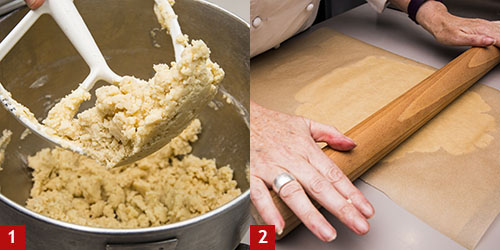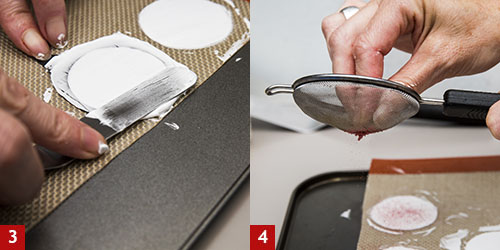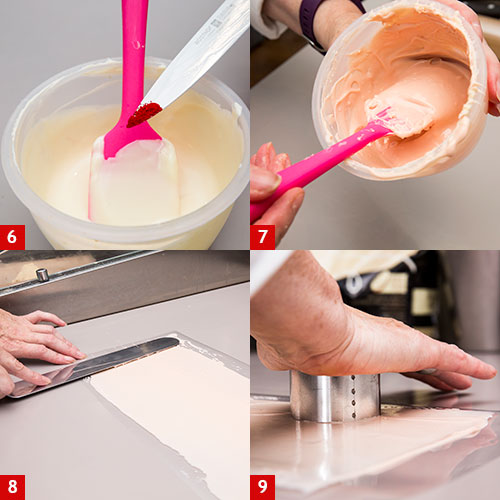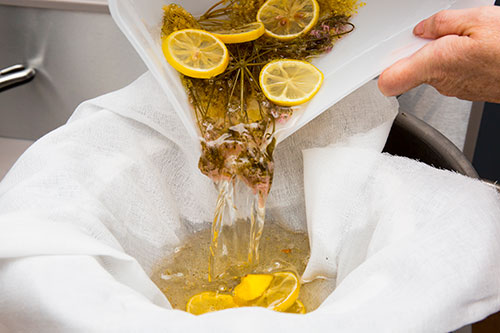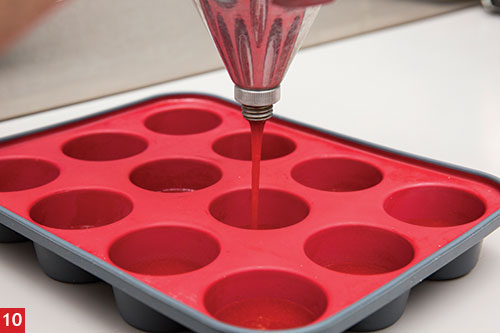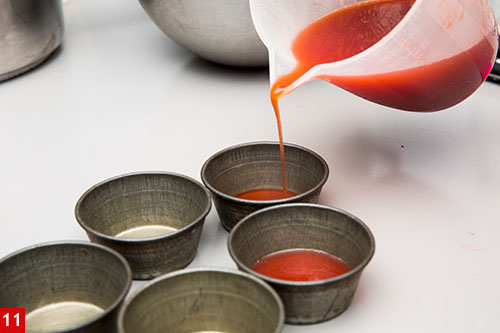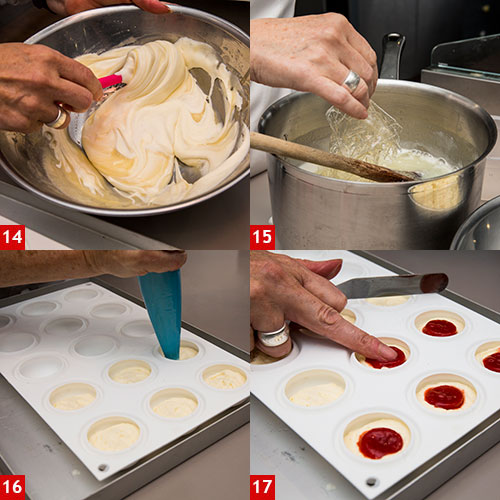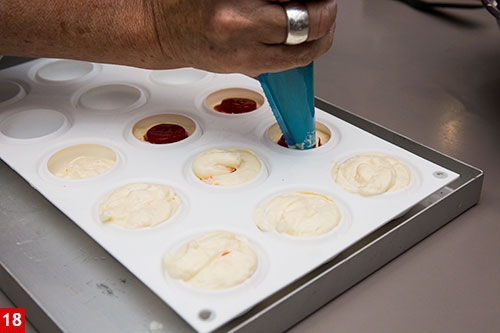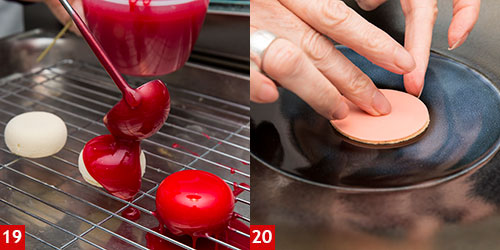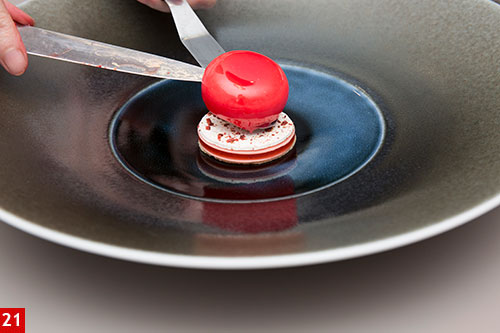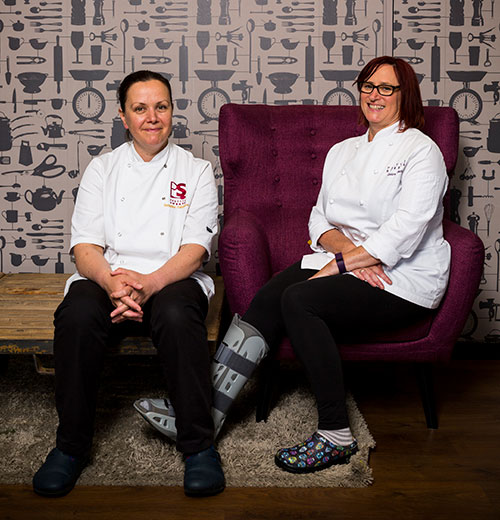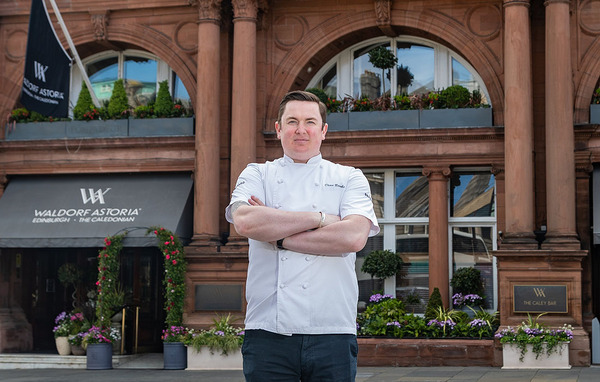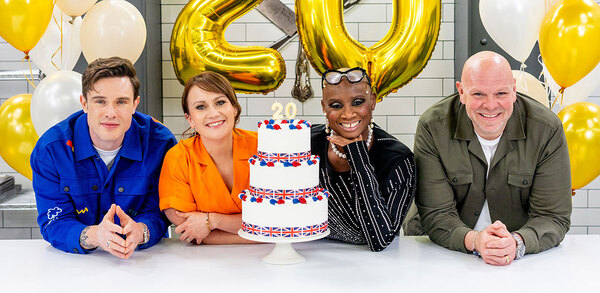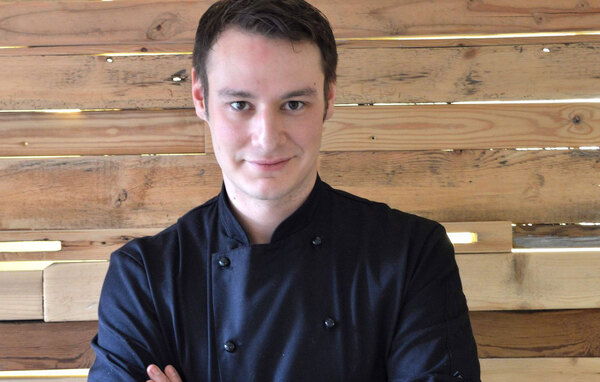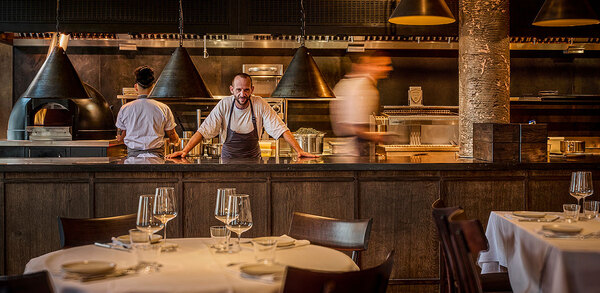Masterclass: Elderflower mousse and strawberry dessert by Claire Clark and Sarah Crouchman
Claire Clark and Sarah Crouchman of pâtisserie catering company Pretty Sweet show Michael Raffael how to create a many-layered elderflower mousse and strawberry dessert
Classic pâtisserie depends on perfect technique. To make her elderflower mousse and strawberries, Pretty Sweet's Claire Clark relies on recipes and skills that would be familiar to a college student, but it's the years of experience spent honing them that has turned the apprentice into a journeyman, then a craftsman, and then, in her case, a creative artist.
On the printed page and on the plate too, the elderflower mousse and strawberries seems complex. In a professional restaurant kitchen or a catering unit, such as what Claire Clark and her partner Sarah Crouchman has at Pretty Sweet, the difficulty lies in planning as much as cooking. For one client they might have to prepare a batch of 2,000; for another, 20.
To meet both contingencies they have to devise methods that perform well. Modern pâtisserie couldn't function without rigorous organisation.
Preparation
- The elderflower cordial is made in early summer and bottled and stored throughout the year.
- The shortbread discs are dusted with strawberry powder and stored in airtight containers with silicone gel.
- The meringue is dusted with grated freeze-dried strawberries and stored in airtight containers with silicone gel.
- The strawberry purée lozenges are deep-frozen.
- The white chocolate is tempered and the white chocolate discs prepared.
- The elderflower and strawberry gin jelly is made.
- The white chocolate glaze is made.
Planning
The elderflower mousse needs 24 hours to set (see recipe). The strawberries should be a mixture of UK alpine, fraises des bois, Kent strawberries and pineberries.
The dish
The components
- Shortbread biscuits
- Meringue discs and pips
- White chocolate discs
- The elderflower mousse
- Strawberry elderflower gin jelly discs, which contain elderflower cordial
- Strawberry lozenges
- White chocolate glaze
- Elderflower mousse
- Gold leaf, strawberry flowers and borage to decorate
Shortbread discs
Makes about 30
- 225g plain flour
- 150g soft unsalted butter
- 75g caster sugar
- Pinch of salt
- Strawberry powder
Note: the recipe can be scaled up without adjustment.
Put the ingredients, bar the strawberry powder, in a mixing bowl with a beater attachment and mix to form a malleable dough (1). Form into a ball (or two smaller balls). Roll out the shortbread paste between silicone sheets. It has to be less than 2mm thick (2).
Rest overnight or freeze. Cut out 50mm discs, dust with strawberry powder and bake 10-15 minutes at 150°C convection or 160°C non-fan assisted oven. Cool and store.
Meringue discs and pips
Makes about 75 discs and 75 pips
- 60g egg whites
- 120g caster sugar
- 2-3 freeze-dried strawberries
Whisk the egg whites with sugar (added a third at a time) to form a stiff meringue. Using a 50mm template roughly 2mm thick, arrange rows of meringue discs on Silpat mats. Scrape off the surface with a palette knife as you go to achieve an even finish (3). Grate the freeze-dried strawberry over the discs (4). Bake for one hour at 100°C to dry out.
Pipe meringue âpipsâ onto a prepared baking sheet (5). Dry out at the same temperature as the discs.
White chocolate discs
Clark prepares a small quantity of white chocolate here, but recommends working with a minimum of 500g chocolate when tempering and using a thermometer.
- 250 white chocolate pistoles, 35% cocoa solids
- 2ml-5ml oil or melted cocoa butter
- Red colouring
- Equipment
- Sheets of acetate, extra boards or trays
Melt the chocolate to 48°C (6). Mix the colouring and oil and add it into the melted chocolate â" a pinch on a knife tip is enough to give a pale strawberry-pink tone (7). Cool to 28°C, stirring from edge to centre (normally this would be done by spreading the chocolate on a marble surface). Reheat to 48°C. Spread 100g chocolate less than 2mm thick on an acetate sheet (8). Cool till set. Cut 50mm discs (9). Turn chocolate over so the acetate is uppermost. Lay it on a silicone-lined tray and put another board on top. Leave for 24 hours to crystallise.
Elderflower cordial
Bring 1.25l water and 750g sugar to the boil with a sliced lemon and 40g citric acid. Boil for two minutes. Pour over 10 sprigs (60g) fresh elderflowers. Leave to macerate for 24 hours. Strain and decant into bottles or jars and sterilize for 20 minutes at 100°C.
Elderflower and strawberry gin jelly discs
Makes about 20
- 100ml strawberry purée
- 100ml gin
- 100ml elderflower cordial
- 3g agar agar
- Squeeze of lemon juice (optional)
Heat the purée, cordial and gin and boil for three minutes. Stir in the agar agar. Spread on a sheet to a depth of 2mm-3mm and leave to set, then cut out 50mm discs. Or use 50mm silicone or tin moulds for less wastage (10).
Strawberry lozenge inserts
Makes about 20
- 200g fresh strawberry purée
- 30g sugar
Heat the fruit and sugar. Pour about 10g per lozenge into containers with roughly 30mm bases and freeze (11). They should each be the size of an Alka-Seltzer.
White chocolate glaze
- 150ml water
- 300g sugar
- 300g liquid glucose
- 200g condensed milk
- 300g white chocolate
- 8 softened silver gelatin leaves
- Cochineal to colour
Aim for about 60ml of the glaze per mousse to allow for a little waste.
Bring the water, sugar, liquid glucose, condensed milk and white chocolate to the boil (12). Dissolve the gelatin in it and add enough colour to achieve a pink rhubarb tone (13). Cool until needed â" this is better left overnight.
Elderflower mousse
Makes 12-14 portions
- 4 silver gelatin leaves
- 40g caster sugar
- 40g egg yolk
- 120ml elderflower cordial
- 200ml double cream
- 8 frozen strawberry lozenges (see above)
Equipment
Pebble moulds for setting and turning out individual mousse portions, 50mm in diameter
Rinse the gelatin till soft but donât leave it to soak. Over a bain marie, whisk the sugar and yolk till theyâre well blended. Add half the cordial and start to whisk in order to make a sabayon (14). When it whitens and thickens add the rest of the cordial and continue whisking till the sabayon has risen fully and the egg has cooked. Whisk in the gelatin to dissolve it (15) and strain through a fine sieve into a fresh bowl.
Whisk the cream until almost firm. When the sabayon has cooled but before it has set, fold in the cream.
Fill a piping bag with the mousse base. Half fill the moulds (16). Place a lozenge in the middle of each one and press it in gently (17). Cover with the rest of the mousse (18).
Freeze ahead of use, at least 24 hours. Turn out, coat with white chocolate glaze and set. Chill or freeze, if necessary, until final assembly.
Assembly
Serves 1
- 1 elderflower mousse
- Melted pink chocolate glaze (about 60ml), just above setting point
- Whipped cream to keep layers together
- 1 shortbread disc
- 2 white chocolate discs
- 1 elderflower strawberry gin disc
- 1 meringue disc
To dress
- 1 meringue pip
- Gold leaf
- A strawberry flower
- Assorted strawberries, sliced and brushed with elderflower cordial
- Borage petals
Put the turned-out mousse on a rack above a tray. Coat with the glaze and leave to set in the fridge (19).
Pipe a small dot of cream in the centre of the plate and put a shortbread disc on it. Put a white chocolate disc on top (20). Pipe another dot of cream and then a jelly disc. Follow with a second layer of chocolate and then meringue.
Lay the glazed mousse on the meringue (21) and decorate it with a meringue pip, a hint of gold leaf and a strawberry flower. Serve sliced strawberries and borage petals brushed with elderflower cordial on the side of the plate.
Claire Clark and Sarah Crouchman
Two years ago, pâtissiers Claire Clark and Sarah Crouchman joined forces to create Pretty Sweet. Their relationship dates back 20 years. Clark, a judge on the recent BBC Two show Bake Off: Crème de la Crème, was head pastry chef at the Portman InterContinental hotel, London, and Crouchman was her third commis. Since then, they became close friends, working together on demos, presentations and special events.
âPeople kept asking Claire to set up a business,â Crouchman says. âOur backgrounds have been in Michelin-starred restaurants and we wanted to work at that level.â
They both felt London had good pâtisseries in the catering sector, but that none were outstanding. âThere was a gap for high-end bespoke work,â says Clark.
They opened, Clark concedes, in a haphazard manner. They invested their own money and took on a shared unit. A week before their first contract was to start, their co-sharer sold up, so they had to find premises for 18 months.
âWe grew so much faster than expected,â Clark says, âthat we decided to move, only we hadnât realised how few units there were available.â Last week they signed on new premises in Park Royal, north-west London.
Early clients included Harrods and O2, both of whom have remained loyal. Clark believes this is because Pretty Sweet doesnât cut corners. âWe use the best ingredients. Instead of a single-plantation Valrhona chocolate we might use its generic one, but we wonât go below that. If a client wants Amedei, thatâs what we buy. Strawberries for this dessert came from Mark Fitzmaurice at 3Star-Veg.â
A few pence may be the only difference between using butter rather than margarine, but the key expense is wages. âGood pastry,â Crouchman says, âis labour intensive. Making macaroons is straightforward, but making icing bees by hand and decorating them, as we did last summer, adds on an enormous amount of extra work. We have trained, skilled staff and they cost a lot of money, but we bring in trainees and bring them up.â Clark has just announced that she is to open her own academy in partnership with Milton Keynes College, further helping to add to the UKâs pool of upcoming pastry chefs.
Â
Â
Â
Â
Â




